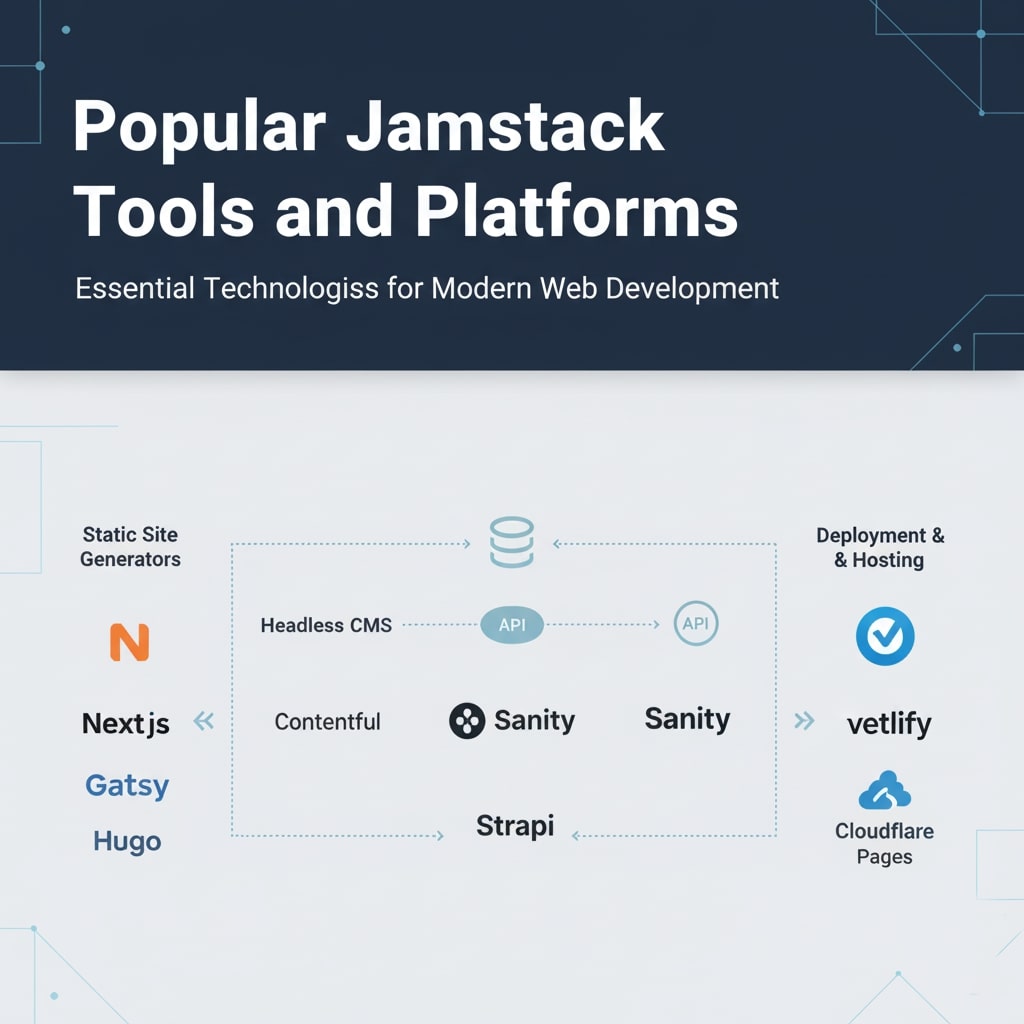In today’s web landscape, users expect lightning-fast load times, rock-solid security, and seamless scalability. Traditional monolithic architectures often struggle to keep up with these demands. Enter Jamstack—a modern web development architecture that decouples the frontend from the backend, harnesses the power of static site generation, headless content management, and global content delivery networks (CDNs). This guide dives deep into the world of Jamstack, exploring its core components, benefits, step-by-step setup, and best practices to help you build enterprise-grade, high-performance websites.
What Is Jamstack?

Jamstack stands for JavaScript, APIs, and Markup. Rather than rendering pages on the server per request, Jamstack sites generate static HTML at build time. Dynamic functionality is achieved through client-side JavaScript and reusable APIs. By shifting rendering to the build process and serving pre-built markup from a CDN, Jamstack delivers unmatched speed, reliability, and security.
Core Components of a Jamstack Architecture
A typical Jamstack project relies on three pillars:
- Static Site Generators (SSGs): Tools like Gatsby, Next.js (in static export mode), Hugo, and Eleventy compile content and templates into static HTML files during build time.
- Headless CMS and APIs: Services such as Contentful, Strapi, Sanity, or even Git-based solutions (Netlify CMS, Forestry) store and manage content. Your frontend fetches data via REST or GraphQL APIs.
- Content Delivery Networks (CDNs): Platforms like Netlify, Vercel, Cloudflare, and Fastly deploy and distribute your static assets across a global network, ensuring minimal latency and maximum uptime.
Key Benefits of Jamstack
1. Unmatched Performance
By serving pre-rendered HTML directly from a CDN, Jamstack pages load in milliseconds. There’s no need to wait for database queries or server-side rendering on each request, resulting in a consistently fast user experience and better Core Web Vitals scores.
2. Enhanced Security
With no direct connection to a server-side application or database at runtime, attack surfaces shrink dramatically. Static files can’t be exploited by SQL injection or server-side vulnerabilities, and any dynamic operations occur through hardened, third-party APIs.
3. Seamless Scalability
Scaling a Jamstack site is as easy as caching and distributing static assets on a CDN. Whether you’re serving a handful or millions of visitors, CDNs handle the load without requiring infrastructure changes or complex auto-scaling configurations.
Building Your First Jamstack Site: Step-by-Step
Follow these steps to create a Jamstack-powered website from scratch:
Step 1: Choose a Static Site Generator
Select the SSG that fits your project requirements and preferred stack. For React developers, Next.js or Gatsby are popular choices. If you favor speed and simplicity, Hugo or Eleventy may be ideal.
Step 2: Set Up Your Project
Use the SSG’s CLI to scaffold a new site. For example, to create a Next.js site, run npx create-next-app my-jamstack-site. Install any additional plugins, themes, or CLI tools needed for your workflow.
Step 3: Integrate a Headless CMS
Choose a headless CMS based on content needs and budget. Configure content models (e.g., pages, blog posts, authors) and set up API credentials. In your frontend code, fetch content at build time using REST or GraphQL calls to the CMS.
Step 4: Add Dynamic Functionality
Use JavaScript to power interactive features like search, forms, or e-commerce. Consider serverless functions (AWS Lambda, Netlify Functions, Vercel Serverless Functions) to handle form submissions, authentication, or custom API endpoints securely.
Step 5: Configure Deployment and CDN
Connect your Git repository to a Jamstack-friendly hosting service (Netlify, Vercel, Cloudflare Pages). Configure build settings and environment variables. The platform will automatically build your site on each push and deploy static assets globally.
Step 6: Optimize for SEO and Accessibility
Generate sitemap.xml, robots.txt, and metadata (title, description, Open Graph tags) at build time. Ensure semantic HTML, alt attributes on images, and proper heading structure for screen readers. Leverage prerendered pages and CDN edge caching to improve SEO crawlability.
Jamstack Best Practices
- Incremental Builds: Use SSGs or hosting platforms that support partial or incremental builds to update only changed pages, speeding up build times for large sites.
- Image Optimization: Integrate image processing libraries (Sharp, Imgix) or cloud-based image services to resize and serve images in modern formats (WebP, AVIF).
- Edge Functions: Offload geolocation, A/B testing, or personalization logic to edge functions for lower latency and better user experience.
- Monitoring and Analytics: Implement real user monitoring (RUM), log forwarding, and lightweight analytics (Plausible, Fathom, or serverless Google Analytics) to gain insights without slowing down pages.
- Accessibility Compliance: Follow WCAG guidelines, use automated testing tools (Axe, Lighthouse), and conduct manual audits to ensure your site is usable by all audiences.
Popular Jamstack Tools and Platforms

Here are some industry-leading tools to power your Jamstack projects:
- Static Site Generators: Next.js, Gatsby, Hugo, Eleventy
- Headless CMS: Contentful, Strapi, Sanity, Netlify CMS
- Hosting & CDN: Netlify, Vercel, Cloudflare Pages, AWS Amplify
- Serverless Functions: AWS Lambda, Netlify Functions, Vercel Serverless Functions
- Image Optimization: Imgix, Cloudinary, Sharp
Conclusion
Jamstack represents a paradigm shift in web development, prioritizing speed, security, and scalability by decoupling the frontend from traditional server-side architectures. By leveraging static site generators, headless CMS platforms, and global CDNs, you can build robust websites that delight users and simplify maintenance. Whether you’re launching a marketing site, blog, or e-commerce store, adopting Jamstack will future-proof your projects and deliver exceptional performance. Ready to get started? Pick your favorite tools, follow the steps outlined above, and join the growing community of Jamstack developers reshaping the web.







